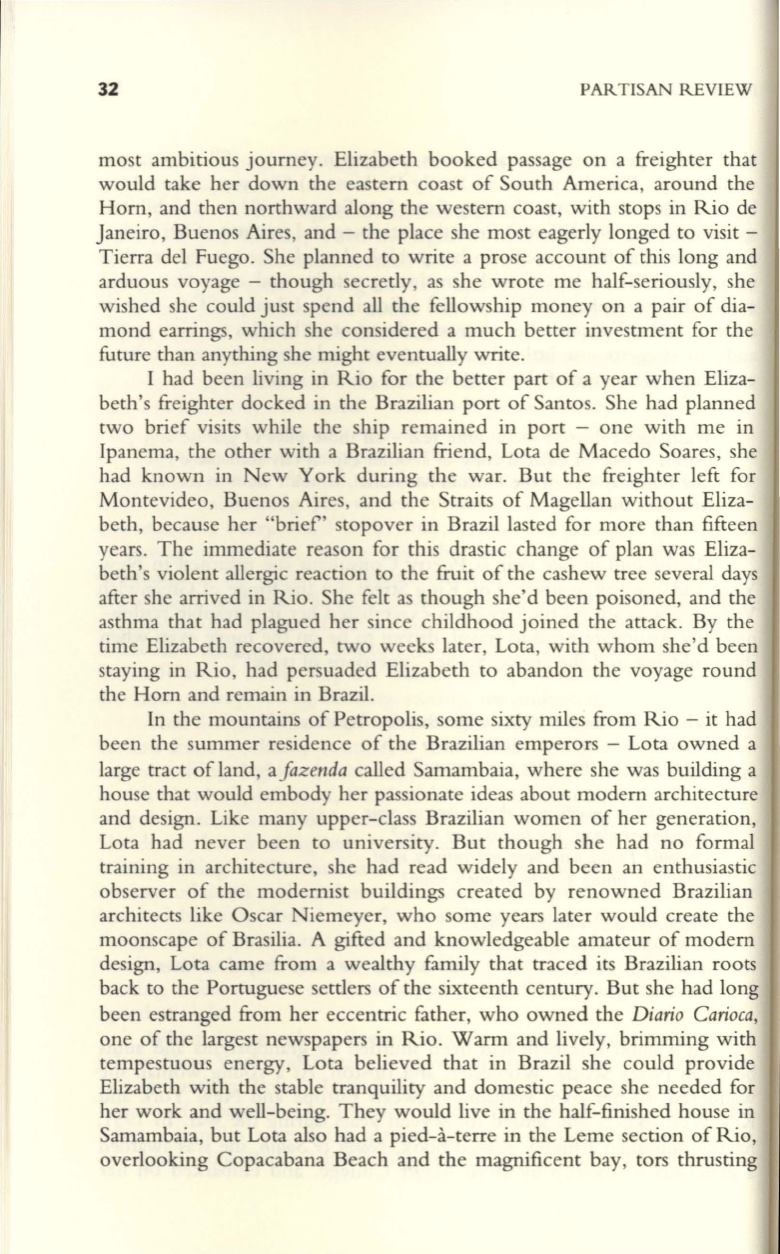
32
PARTISAN REVIEW
most ambitious journey. Elizabeth booked passage on a freighter that
would take her down the eastern coast of South America, around the
Horn, and then northward along the western coast, with stops in Rio de
Janeiro, Buenos Aires, and - the place she most eagerly longed to visit -
Tierra del Fuego. She planned to write a prose account of this long and
arduous voyage - though secretly, as she wrote me half-seriously, she
wished she could just spend all the fellowship money on a pair of dia–
mond earrings, which she considered a much better investment for the
future than anything she might eventually write.
I had been living in Rio for the better part of a year when Eliza–
beth's freighter docked in the Brazilian port of Santos. She had planned
two brief visits while the ship remained in port - one with me in
Ipanema, the other with a Brazilian friend, Lota de Macedo Soares, she
had known in New York during the war. But the freighter left for
Montevideo, Buenos Aires, and the Straits of Magellan without Eliza–
beth, because her "brief' stopover in Brazil lasted for more than fifteen
years. The immediate reason for this drastic change of plan was Eliza–
beth's violent allergic reaction to the fruit of the cashew tree several days
after she arrived in Rio. She felt as though she'd been poisoned, and the
asthma that had plagued her ince childhood joined the attack. By the
time Elizabeth recovered, two weeks later, Lota, with whom she'd been
staying in Rio, had persuaded Elizabeth to abandon the voyage round
the Horn and remain in Brazil.
In the mountains of Petropolis, some sixty miles from Rio - it had
been the summer residence of the Brazilian emperors - Lota owned a
large tract of land, a
Jazenda
called Samambaia, where she was building a
house that would embody her passionate ideas about modern architecture
and design. Like many upper-class Brazilian women of her generation,
Lota had never been to university. But though she had no formal
training in architecture, she had read widely and been an enthusiastic
observer of the modernist buildings created by renowned Brazilian
architect like Oscar Niemeyer, who some years later would create the
moonscape of Brasilia. A gifted and knowledgeable amateur of modern
design, Lota came from a wealthy family that traced its Brazilian roots
back to the Portuguese settlers of the sixteenth century. But she had long
been estranged from her eccentric father, who owned the
Diario Carioca,
one of the largest newspapers in Rio. Warm and lively, brimming with
tempestuous energy, Lota believed that in Brazil she could provide
Elizabeth with the stable tranquility and domestic peace she needed for
her work and well-being. They would live in the half-finished house in
Samambaia, but Lota also had a pied-a-terre in the Leme section of Rio,
overlooking Copacabana Beach and the magnificent bay, tors thrusting


